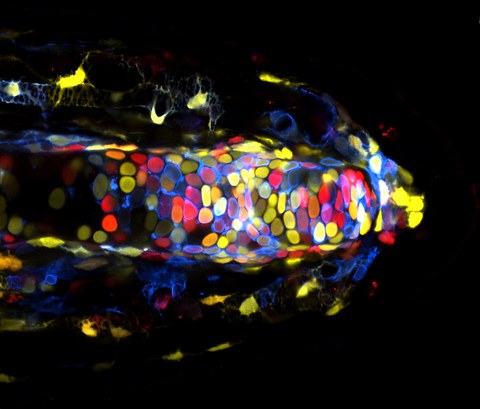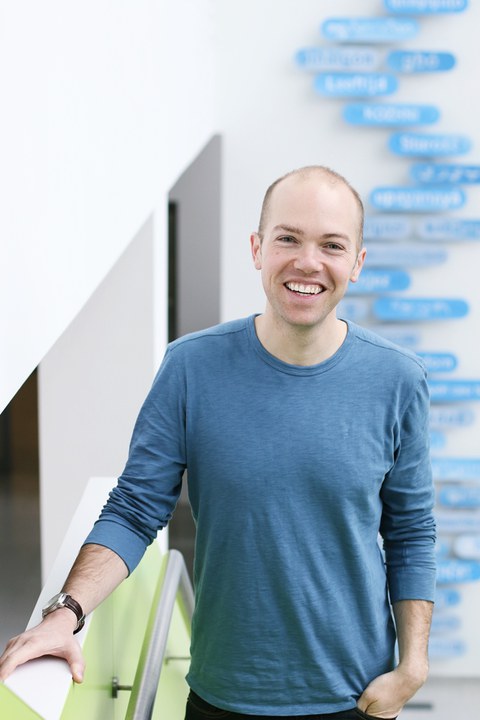Nov 21, 2016
Research team at the CRTD identifies the cells that form new bone during Axolotl finger regeneration

Brainbow-labeled connective tissue in the regenerating axolotl fingertip (The brainbow labeling technique permanently labels cells with a random range of color combinations that will be passed on to the cell’s progeny after division. Circular cells in the center of the micrograph represent the skeletal cartilage cells that are wrapped on the sides by periskeletal cells. Yellow cells along the periphery are dermal cells.)
Tracking down bone regeneration: At the DFG-Center for Regenerative Therapies Dresden (CRTD) - Cluster of Excellence at the TU Dresden, a team of researchers lead by Joshua Currie, PhD, and Elly Tanaka, PhD, used live imaging during axolotl regeneration to identify the unique migration kinetics of various connective tissue cell types which choreograph their fate and tissue contribution during regeneration. The results were published in the scientific journal Developmental Cell on November 21, 2016.
The axolotl is a champion of regeneration, with the ability to completely regenerate the limb skeleton and heal wounds without forming scars. Understanding how this process happens holds promise to improve the outcome of bone regeneration after fracture as well reduce scaring during wound healing. After amputation of the axolotl limb, cells are recruited to the site of injury and build a mass of cells, called the blastema, which will build the lost portions of the limb. An outstanding question has been “Where exactly do the cells for the blastema come from?” Using a multi-color labeling technique and live imaging of regeneration in the axolotl fingertip, Currie et al. found that cells surrounding the bone and cells beneath the skin move into the wound site to build the lost skeleton of the fingertip. Finally, the team identified a growth factor, PDGF-BB (Platelet-derived growth factor BB), that was essential for activating cells to migrate to the site of injury and form the regenerative blastema.
“In the future it will be important to understand how PDGF-BB, a growth factor also found in humans, is able to activate cells to migrate and if human wounds could benefit from treatment with PDGF-BB to recruit more cells to aid in regeneration and scar free healing,” says the study’s first author, Joshua Currie, PhD.
Since 2011, Joshua Currie, PhD, has worked as a Postdoctoral Fellow at the CRTD. In 2011 he completed his Doctor of Philosophy at the University of North Carolina (Chapel Hill, North Carolina, USA). Before, he worked as a Research Assistant at Vanderbilt University (Nashville, Tennessee, USA).
Elly Tanaka, PhD, Professor of Animal Models of Regeneration at the Technische Universität Dresden, in the DFG Research Center, Cluster of Excellence for Regenerative Therapies (CRTD) from 2008-2016. Since September 2016, Senior Scientist at the Research Institute of Molecular Pathology (IMP) in Vienna, Austria.
Publication
“Live Imaging of Axolotl Digit Regeneration Reveals Spatiotemporal Choreography of Diverse Connective Tissue Progenitor Pools”
DOI: http://dx.doi.org/10.1016/j.devcel.2016.10.013
Related publications
Prayag Murawala, Elly M. Tanaka, Joshua D. Currie. ”Regeneration: The Ultimate Example of Wound Healing,” Seminars in Cell and Developmental Biology, 23(9), 954-962, 2012.
Tanaka EM. The Molecular and Cellular Choreography of Appendage Regeneration. Cell. 2016 Jun 16;165(7):1598-608. DOI: 10.1016/j.cell.2016.05.038.
Other publications by Joshua Currie, PhD
Other publications by Elly Tanaka, PhD
Media inquiries
Franziska Clauß, M.A.
Press Officer
Tel.: +49 (0) 351 458 82065
Founded in 2006, the DFG Research Center for Regenerative Therapies Dresden (CRTD), Cluster of Excellence at the TU Dresden has now passed the second phase of the Excellence Initiative which aims to promote top-level research and improve the quality of German universities and research institutions. The goal of the CRTD is to explore the human body's regenerative potential and to develop completely new, regenerative therapies for hitherto incurable diseases. The key areas of research include haematology and immunology, diabetes, neurodegenerative diseases, and bone regeneration. At present, eight professors and ten group leaders are working at the CRTD – integrated into an interdisciplinary network of 87 members at seven different institutions within Dresden. In addition, 21 partners from industry are supporting the network. The synergies in the network allow for a fast translation of results from basic research to clinical applications. https://www.crt-dresden.de


